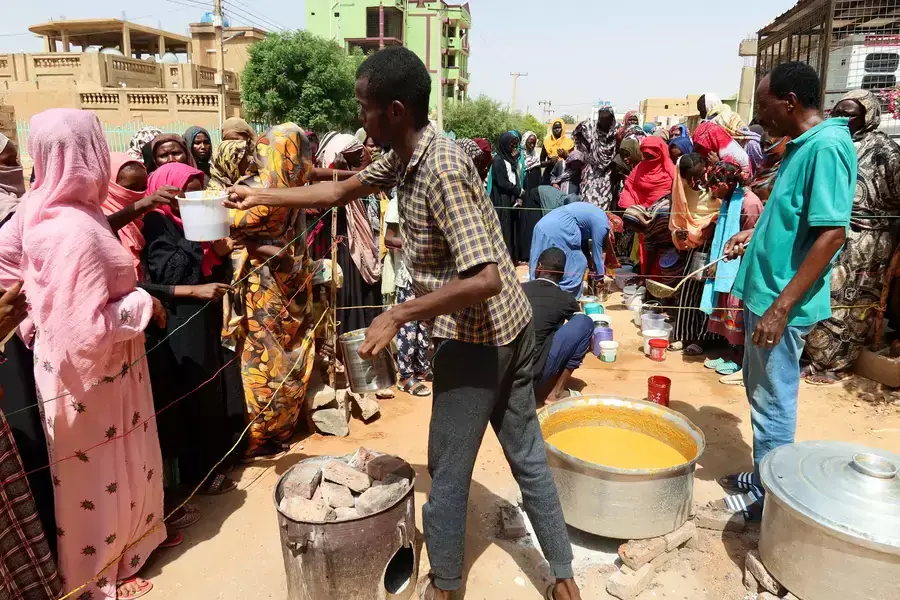Supporting Sudanese agency in the ongoing conflict will boost confidence-building measures for a sustained peace.
Sudanese civilians continue to live under the harsh conditions of war, displacement, and inaccessibility. From all indications, the physical and mental toll of the conflict will be felt for the foreseeable future. Unfortunately, the United Nations’ $2.6 billion emergency aid program remains only a quarter funded. With more than one hundred days having passed since the initial eruption of violence on April 15, conflict fatigue looks to be setting in both diplomatically and financially. Although the operational terrain for civil society in Sudan is arduous, various Sudanese civil society groups are working to create an environment for peace in the country. Local leaders and organizers are preparing and delivering ready-made meals, medicine, and hygiene kits for internally displaced people (IDPs), and community organizations in Kassala and Gadarif conduct welfare activities performing songs, theater plays, and guidance programs for conflict-affected citizens seeking support.
Both the Sudanese Armed Forces (SAF) and the Rapid Support Forces (RSF) occupy different parts of the country, leading to major clashes between armed groups and local communities. With much of West and Central Darfur under the control of the RSF and much of the eastern and southern regions of Sudan under SAF control, the spread of violence is a recurring factor in the search for peace. Incidents such as the death of Western Darfur Governor Khamis Abdallah Abbakar, an airstrike that killed twenty-two civilians in Omdurman, the discovery of a mass grave containing eighty-seven civilians, and clashes between SAF and the Sudan People’s Liberation Movement–North (SPLM-N) in South Kordofan are just a few in a series of violent events that have erupted outside of Khartoum. The conflict between the SAF and RSF has displaced over five million people since April.
With a growing number of regions in Sudan embroiled in the conflict, many fear that a major ethnic conflict could reach a boiling point, particularly amongst local communities and armed forces. The addition of the SPLM-North to the conflict in southern Kordofan and Blue Nile is a prime example of how sustained violence is fracturing Sudan’s social and security fabric.
As we focus on the immediate need to end hostilities across the country, there needs to be an equivalent focus on securing a country-wide ceasefire, creating a safe humanitarian corridor, and a sustained peace environment throughout the country. Once hostilities have decreased, there must be clear and measurable goals for peace and prosperity.
With places like El-Obeid, Kadugli, and El-Geneina becoming arenas of conflict, many Sudanese civilians have been caught in the crossfire. The Washington, D.C.-based Search for Common Ground (SFCG) found that children were most impacted in Blue Nile and North Kordofan, elders were most affected in Khartoum, and women were disproportionately affected in Gadarif and Kassala. The surge in gender-based violence is another sign that the targets of this war transcend the armed forces.
Communities continue to deal with spikes in violence, while citizens needing humanitarian support continue to struggle to receive relief and basic services. Aid agencies continually report that violence and armed forces block aid access for many Sudanese communities, and public resources such as electricity, water, health, and communication networks are reportedly shut off throughout most states. In Khartoum, specific areas such as markets, schools, hospitals, roads, and government institutions remain inaccessible due to the conflict. SFCG data indicate that an overwhelming number of Sudanese experience significant economic disruptions and destruction of infrastructure as additional consequences of the ongoing conflict.
With an average of 33 percent of respondents from Blue Nile, Khartoum, Gadarif, and Kassala reported feeling unsafe walking alone in their area, several local, Sudanese-led initiatives are playing key roles in facilitating preventative measures against violence. Local citizen coalitions across many states are negotiating for peace markets, community kitchens, and conflict-free zones for power stations, commerce, and transportation with SAF & RSF. Community leaders are coming out to denounce stealing and looting from conflict zones as broader coalitions of citizens appeal to the humanity of the armed forces. While Sudanese civilians work to protect their livelihoods, 44 percent of Sudanese respondents consider violence to be justified when defending their livelihood. It is essential to support confidence-boosting measures such as these Sudanese local initiatives to ensure violence prevention and the preservation of Sudanese citizens’ livelihoods.
As multilateral negotiations to end the conflict continue, we should urge international mediators to consider the political and social environment in Sudan once the weapons fall silent. Whatever programming and rehabilitation the international community would like to see in post-conflict Sudan, it must start budgeting and allocating for it today. Whether it is an African Union, Intergovernmental Authority on Development (IGAD), or US-Saudi Arabia-led process; including local communities, particularly women and young people, in peace talks is paramount for sustained peace in Sudan.

